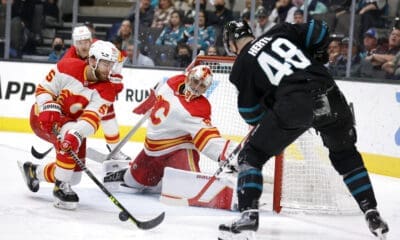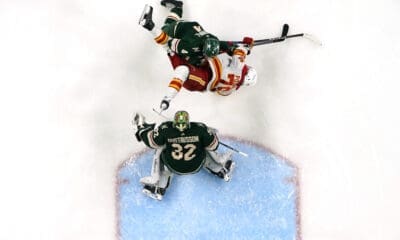Calgary Flames
The Flames Blocked Shot Conundrum: Part One – Are Blocked Shots Bad?

The Flames were the best team at blocking shots last year. As a matter of fact, they had the most blocked shot of any team over the past five years. In five-on-five situations, they blocked 1,179 shots. They’ve already broken that mark this year. So far this season, they’ve tallied 1,184 blocked shots five-on-five this season with nine games left to play.
Per 60 minutes of play, they’re blocking 20.04 shots five-on-five. That’s over 1.2 more blocked shots per 60 minutes than the next closest team, the Buffalo Sabres. Before that, no team over the past five seasons was blocking more than 18 per 60 minutes.
All of this is notably great according to the television personalities that comment on the game. After all, blocking a shot means that it has no chance of going in. This obviously mean less goals against which should lead to more points at the end of the season which means more success.
Those with a more analytical mindset state otherwise. To them, a blocked shot means the puck is in the wrong end of the ice. Others will counter that a blocked shot shouldn't count towards possession as there is zero chance of scoring. That leads to the first point.
There's Correlation Between Blocked Shots and Possession
There is a statistical correlation between blocked shot for percentage and the rest of the the possession statistics. The correlation is obviously heaviest between that and Corsi, but there is at least moderate correlation between the blocked shots and all measurements of possession. Using the R values of each set gives a better understanding of this.
| Correlation with Blocked Shot Percentage | |||||
|---|---|---|---|---|---|
| CF% | SCF% | FF% | SF% | GF% | |
| 2010-2011 | -.776 | -.522 | -.587 | -.524 | -.418 |
| 2011-2012 | -.845 | -.652 | -.659 | -.603 | -.509 |
| 2012-2013 | -.841 | -.641 | -.692 | -.566 | -.080 |
| 2013-2014 | -.895 | -.753 | -.794 | -.723 | -.498 |
| 2013-2014 | -.895 | -.823 | -.771 | -.723 | -.392 |
| All Seasons, All Teams | -.860 | -.701 | -.715 | -.642 | -.369 |
| 5 Year Sample Sizes | -.874 | -.707 | -.746 | -.668 | -.436 |
Listed here in the chart is the data from each team over the past five seasons along with all seasons separately for each team over the last five seasons and the five year sample size for each team. Corsi of course has the strongest correlation as it includes blocked shots, but Fenwick for and shots for also have high rates of correlation. Given that they are somewhat uniform throughout each season, it's safe to assume that there is at least a moderate link between blocked shots and other possession statistics.
The one outlier in this is goals for. With goals for there were three seasons of moderate correlation, one that was weak, and one that was basically statistically irrelevant. Across all seasons, the data was weak, but closer to moderate. When all teams were combined, the five year sample sizes showed moderate correlation which of course would be higher if the outlying statistical season was removed.
Given that the data shows at least a moderate correlation for each season it's safe to assume that there is some causation to the correlation. This is extremely bad news for the Flames. Currently the Flames are third in the league with a 58.29% blocked shot for percentage. That would turn out to be the third highest rate over the past five seasons. Given that there is negative correlation between the two, that means that the Flames will generally wind up on the wrong side of the score sheet on most occasions. They had the highest rate in the league last year which means that this might be a coaching philosophy and if so it's a very flawed one.
Obviously this isn't great, but this is a percentage of blocked shots for versus against and how they correlate with other possession metrics. What about the raw blocked shot data? The statistical correlation there isn't as strong, but it's still moderate and once again it bodes poorly for the team's future should they continue down the path they've traveled.
Blocked Shots do not Lead to Less Shots Against, but Less Shots For
Logic would dictate that a blocked shot means one less shot against per game. The data shows otherwise as the R values of show that more blocked shots lead to more shots against, albeit with an extremely weak correlation. When missed shots are included, the data correlation is higher, but still weak.
| Correlation with Blocked Shots per 60 Minutes | ||||||||||
|---|---|---|---|---|---|---|---|---|---|---|
| CF60 | CA60 | SCF60 | SCA60 | FF60 | FA60 | SF60 | SA60 | GF60 | GA60 | |
| 2010-2011 | -.567 | .568 | -.185 | .411 | -.642 | .133 | -.557 | -.001 | -.305 | .156 |
| 2011-2012 | -.778 | .778 | -.486 | .441 | -.744 | .392 | -.693 | .221 | -.364 | .270 |
| 2012-2013 | -.675 | .674 | -.508 | .227 | -.689 | .310 | -.598 | .097 | .211 | .036 |
| 2013-2014 | -.732 | .732 | -.569 | .487 | -.770 | .391 | -.752 | .215 | -.331 | .260 |
| 2013-2014 | -.760 | .759 | -.591 | .618 | -.782 | .394 | -.787 | .249 | -.283 | .218 |
| All Seasons | -.711 | .711 | -.498 | .435 | -.735 | .329 | -.691 | .164 | -.213 | .178 |
| 5 Year Team Samples | -.731 | .729 | -.480 | .473 | -.775 | .332 | -.727 | .115 | -.254 | .237 |
The data in the chart has been adjusted for Corsi pace. Teams with higher combined Corsi attempts were lowered to the league average while lower teams were raised to the league average. The data shows extremely weak correlation in the against columns for goals against and shots against and a weak but slightly higher relevancy with Fenwick against.
The data for may show a different effect than many would expect. Blocked shots have a high relevancy to Corsi, Fenwick, and shots for with less correlation with scoring chances for. Goals for has some negative correlation in four out of five seasons with the exception of the strange 2012-2013 lockout season. Still, it's safe to assume that teams that block more shots will seeing a negative impact with regards to their shot attempts, and to a much lesser extent, their scoring.
Blocked shots for shows that there's a negative correlation with getting attempts on net while also having positive correlation (which is a bad thing thing) on the opponents' ability to do so. Logic would dictate that this means that forcing the opponent to block more shots would have the inverse effect. In this case the old idiom "the best defense is a good offense" rings true.
There's a Greater Statistical Correlation Between Blocked Shots Against and Scoring Against than Blocked Shots for and Scoring For
Much is made of the Flames' ability to block shots, but the truly beneficial talent seems to be in forcing the opponent to block more shots. There is a higher statistical relevancy to forcing the opponent into blocking shots and limiting their scoring chances than there is with simply allowing them to have an attempt and trying to block it. The R values show that this even carries over with at least a moderate correlation to goals while with blocked shots for there was very little correlation.
| Correlation with Blocked Shots per 60 Minutes | ||||||||||
|---|---|---|---|---|---|---|---|---|---|---|
| CF60 | CA60 | SCF60 | SCA60 | FF60 | FA60 | SF60 | SA60 | GF60 | GA60 | |
| 2010-2011 | .559 | -.560 | .295 | -.356 | .195 | -.640 | .089 | -.692 | .121 | -.451 |
| 2011-2012 | .669 | -.666 | .363 | -.324 | .399 | -.598 | .304 | -.550 | .206 | -.314 |
| 2012-2013 | .758 | -.758 | .430 | -.725 | .570 | -.741 | .485 | -.625 | .009 | -.423 |
| 2013-2014 | .825 | -.824 | .614 | -.667 | .692 | -.842 | .609 | -.734 | .244 | -.528 |
| 2013-2014 | .805 | -.807 | .656 | -.661 | .612 | -.799 | .522 | -.705 | .187 | -.459 |
| All Seasons | .729 | -.729 | .479 | -.566 | .500 | -.735 | .398 | -.667 | .150 | -.429 |
| 5 Year Team Samples | .717 | -.719 | .472 | -.515 | .515 | -.763 | .392 | -.678 | .188 | -.567 |
While there is correlation with blocked shots against and shots for, it's weak to moderate correlation. With the correlation with shots against it's moderate to strong and there's even a somewhat relevant link with goals against, where with blocked shots for, there wasn't exactly a lot. There wasn't a single example where the correlation was positive. Opponents blocking shots didn't do anything to inhibit a team's ability to score either, as there was at least positive correlation in every metric measuring shots and goals for across every season and the five year sample sizes.
For the Flames, this is okay. They are 19th in the league in forcing the opponent to block shots. This is exactly where they ranked last year, but they're forcing opponents into blocking about .45 attempts more per 60 minutes when adjusted for pace of play. That's the plus side.
The downside is that they're trending in the wrong direction when it comes to net blocking shots. They're currently blocking 5.52 more shots than their opponents per 60 minutes, while last season they were blocking 4.49 more. If they continue at this pace they're likely to irreparably break the team.
There's a myriad of different reasons as to how Calgary has been able to overcome its blocked shot dilemma. Many have talked about the P.D.O., the shooting percentages and the goaltending. There are other reasons as well, but those are a story for another day.
by Les Mavus









